News & Podcast
2008 Fall Newsletter
Download PDF
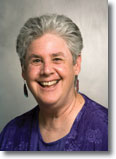 If you’re like me, you became an Olympics fanatic this past
August—soaking in the amazing performances of Dara Torres and Natalie
Coughlin in swimming, Nastia Liukin and Shawn Johnson in gymnastics,
Sonya Richards and Allyson Felix in track, and many talented athletes
competing in basketball, soccer, softball and volleyball. The Tucker
Center applauds their accomplishments and basks in the glory of their
successes.
If you’re like me, you became an Olympics fanatic this past
August—soaking in the amazing performances of Dara Torres and Natalie
Coughlin in swimming, Nastia Liukin and Shawn Johnson in gymnastics,
Sonya Richards and Allyson Felix in track, and many talented athletes
competing in basketball, soccer, softball and volleyball. The Tucker
Center applauds their accomplishments and basks in the glory of their
successes.
To celebrate the Olympics, we are excited to announce the theme of our Fall Distinguished Lecture: “Minnesota Female Olympians: Stories, Experiences & Inspirations.” Professor Doug Hartmann will frame the social and historical context of the Games and then moderate a panel of Olympians with Minnesota roots—Janis Klecker, marathon in Barcelona (1992); Carrie Tollefson, 1500 meters in Athens (2004); and Shani Marks, triple jump in the 2008 Beijing Olympics.
Though there’s clearly much to honor about personal bests and medal performances, media images continue to reinforce stereotypes about the role and significance of elite female athletes. Coverage of women’s events paled in comparison to men’s during prime time, and stories focused less on women’s athletic accomplishments than on motherhood, skimpy outfits in beach volleyball, and their age (the title on a Sports Illustrated article featuring Dara Torres was “One for the Aged”).
In light of these persistent and pervasive stereotypes, it is not too surprising that a new book has recently appeared on bookshelves across the nation—Warrior Girls by Michael Sokolove (following a cover story in the New York Times Magazine last spring). Sokolove implores: “Everyone wants girls to have as many opportunities in sports as boys. But can we live with the greater rate of injuries they suffer?” The author perpetuates the essentialist argument that male athletes are superior to female athletes based on the so-called biological imperative that females are physically weaker, more vulnerable, and more prone to injury.
The Tucker Center asked scholars from varying academic disciplines to respond to these age-old and troubling arguments. Nicole LaVoi begins with a sociological perspective, followed by critiques from Public Health (Toben Nelson), Sports Medicine (Steve Stovitz and Liza Arendt), and Sport Psychology (Diane Wiese-Bjornstal). We encourage you to offer your own perspective on Warrior Girls by logging onto the Tucker Center Web site.
-- Maureen Weiss, Co-Director
To learn more about Professor Weiss and her new role as co-director of the Tucker Center, go to Maureen Weiss.
In 2008, a controversial book—Michael Sokolove’s Warrior Girls: Protecting Our Daughters Against the Injury Epidemic in Women’s Sport—was released, along with a companion article which appeared in the May 11 issue of the New York Times Magazine. The premise of the book asserts that “[the] immutable facts of anatomy and physiology” cause girls to incur significantly more sport injuries (e.g., ACL tears, concussions) than their male counterparts, resulting in what Sokolove terms a female “injury epidemic.” As a response to the underlying premise (and purported facts) of Warrior Girls, the Tucker Center felt it necessary to provide a scholarly critique from relevant academic disciplines. We invited internationally recognized scholars from the U of M in Public Health, Sports Medicine, Sport Psychology and Sociology to read the book and respond independently. Their perspectives—and research findings—follow.
A Sociological Perspective
Nicole M. LaVoi, Ph.D. Associate Director, Tucker Center
Let me begin by stating that sport injuries and sport injury prevention are very real and important issues—for both girls and boys. However, framing the issue of sport injuries as an inevitable biological difference based on the sex of the athlete is sensationalistic and irresponsible. First, an argument based primarily on biology and physiology altogether ignores that sport performance (and therefore injury) is also shaped by social forces such as coaches’ and parents’ beliefs about what it means to be a “female athlete.” Second, this sort of deterministic approach assumes that males, by definition, are naturally (physically) superior to females. In this framework, male athletes are the norm to which females are constantly compared, and any gender differences are therefore constructed as inherent female deficiencies. The consequence of such biology-is-destiny arguments? Professor Cheryl Cooky, Cal State-Fullerton, sums it up best: “Concerns regarding the supposed biological limitations of the female body to withstand rigorous athletic competition have historically served to justify restricting girls’ and women’s access to sport.”
Though Sokolove does indicate that we should also be concerned about sport injuries males sustain, rarely, if ever, are books published devoted to the negative consequences of sport participation on the health and well-being of boys and men. Interestingly, a search for a similar book or article on the “epidemic” of male sport injuries yielded nothing, despite published research which indicates that NFL players’ life expectancy is 15-20 years lower than the general American male population and that many suffer ill effects from playing professional football, including obesity, heart disease, chronic pain and crippling arthritis.
The anatomy-is-destiny perspective also ignores the reality that some female athletes are stronger, have better motor skills, are more coordinated than some male athletes, and that risk for injury runs along a continuum rather than a sex-determined binary. In the final analysis, males and females are more similar than they are different—both compete in sports and both get injured in a variety of sports and physical activities. As a result, concerns relating to all the correlates of sport injury, social and psychological as well as biological and physiological, need to be given equal consideration.
A Public Health Perspective
Toben F. Nelson, Ph.D. Assistant Professor, Epidemiology & Community Health
Warrior Girls tells compelling stories of exceptional young women as they struggle with serious sports injuries—stories that need to be told. The author is sensitive to the hard-won gains that have opened doors for young women to experience the benefits of sport. We cannot go back. Higher sport injury rates among girls is not evidence of weakness nor an indication they should not play. But that does not excuse serious efforts at understanding the etiology and distribution of sports injury, with the goal of prevention. Sokolove does raise important questions about sport injuries, but the prescriptions he offers are preliminary and unsatisfying. Should we push young women to play hard? Should we allow them to push themselves? Do young women lack the self-awareness to know when they have gone too far? Such questions send us backward, not forward.
Though the personal stories Sokolove highlights are compelling, they restrict our vision of the full problem—if we use only the comparison of girls to boys, we remain limited in our overall understanding. While it might be tempting to wonder about the physical attributes of young women that may make them susceptible to injury, we also need to ask questions about the conditions that contribute to injury rates among young men. Fundamental inequities still exist between sport opportunities for boys and girls. Do differences in field conditions, types of equipment or coaching styles contribute to higher injury rates?
Some excellent work has been done to study sports injury using NCAA Injury Surveillance data. Although these data are the best available, they are incomplete, and as a result, reliable answers about adequate prevention remain elusive. Expanding the set of questions we ask—and collecting the right data to answer them—will go far in furthering our understanding of the complexities surrounding this issue. Sports participation can be a safe and rewarding pursuit. We should continue to strive to protect young women (and men) from the risks they encounter in sport through rigorous science.
A Sports Medicine Perspective
Steven D. Stovitz, MD, FACSM Assistant Professor, Department of Family Medicine and Community Health
Elizabeth A. Arendt, MD, FACSM Professor, Department of Orthopedic Surgery
As sports medicine providers, we are aware of the devastation that an ACL tear can have on both the musculoskeletal system and the mental health of an adolescent. In certain sports, females sustain a higher rate (not a greater number) of non-contact ACL injuries when compared with males. However, the emphasis on the emotional interplay among the athletes, parents and coaches Sokolove writes about detracts the focus from a more scientific presentation of injury risk. Warrior Girls suffers from the following: 1) False comparisons—One major theme is that females simply can’t do what males do. Therefore, when they try to “act like males,” meaning be competitive, powerful and aggressive, they will inevitably become injured. 2) Misrepresentation of scientific literature—We don’t know why girls suffer ACL injuries at rates higher than boys. Theories include factors such as differences in strength, joint laxity and gait. The author presents each theory as a “known risk factor” implying that all girls inherently contain every risk factor which places all females at enormous risk. 3) Fudging of statistics—Imagine something happens in 0.1% of population X, and 0.2% of population Y. You could say that the difference between the populations is 0.1% (i.e., the absolute difference), or you could say that the difference is 50% (i.e., the relative difference). While both numbers have meaning, when discussing an ACL injury prevention program, Sokolove only presents the relative difference—in this case, 74% fewer ACL tears occurred in girls who completed an ACL prevention program compared to girls who did not complete the program. A more honest (and accurate) approach would be to present both numbers. 4) Emotional language—“The ACL does not tear so much as it explodes”, and “parents scream ‘No! No! Oh, no!’ from the sidelines.” Such overwrought language permeates Sokolove’s writing and contributes to the sense of fear he creates when discussing the “injury epidemic” he claims exists.
There is an identifiable gender disparity with regard to non-contact ACL injuries. To address this concern, parents and coaches could, for example, be much more aware of ACL injury prevention training and its many benefits for females and males. Unfortunately, these critical messages get lost within Sokolove’s over-the-top and misleading approach.
A Sport Psychology Perspective:
True Confessions of a Warrior Girl turned Mild-Mannered Soccer Mom
Diane Wiese-Bjornstal, Ph.D. Associate Professor, School of Kinesiology; Association of Applied Sport Psychology Certified Consultant
In many ways I was a “warrior girl”; still am, I think. So I truly do understand what these girls feel: The over-powering desire to mask pain, injury or fatigue so as not to miss a moment of playing time, give less than 100% or appear weak. But fortunately for me, this style wasn’t an option at the tender age of 10 or younger as it is for girls—and boys—today, so I survived relatively unscathed at least until college. Being a Sport Psychology Professor by day and a mild-mannered soccer mom by night, I view the topics in Sokolove’s book through two lenses. As a scholar, I see that our studies of the psychological reactions of athletes post-injury have illustrated the same full spectrum of cognitive, emotional and behavioral responses reflected in the book’s many anecdotes. Sadly, some young athletes express “relief” after sustaining an injury because they feel it is the only way to escape the pressures of sports and still “save face.” Pre-injury studies reveal that those athletes who are physically and mentally fatigued—self-imposed, such as perfectionist standards, and other-imposed, such as pressure from coaches or travel time—are more likely to sustain injuries.
As a mom, I see that parental responsibility for athlete health is often abdicated to coaches. The unhealthy decisions that parents sometimes make for young athletes—and that Sokolove highlights with such powerful examples as “we can’t stop her, she has a mind of her own,” or “I don’t want to ‘waste’ her talent”—are simply bogus. I admire those parents described in the book who drew the line in the sand when an athlete’s health was in jeopardy. But parents should also realize their beliefs and values about physical activity greatly influence their child’s behavior. Research indicates that far too often, parents perceive girls are more vulnerable, and thereby allow, even encourage, greater risk taking for boys which, ironically, puts them more at risk for injury than girls. This research finding provides additional evidence against the biology-is-destiny argument.
In sum, we must help all of our children learn to take reasonable risks within healthy boundaries in all aspects of life, sports included.
Conclusion
Warrior Girls is based on sensationalistic journalism rather than empirical evidence. Sokolove skillfully links the sport ethic—striving for distinction, accepting risks, playing through pain and not accepting barriers in the pursuit of goals—with a Mars-Venus dichotomy whereby females are routinely portrayed as different from (and inherently inferior to) males. He seems determined to create a moral panic for already overly concerned sport parents who are understandably trying to do what is best for their daughters. In Sokolove’s worldview, parents are confronted with a falsely constructed dilemma—wanting equal sport opportunities for their daughters, but in so doing, placing their daughters in harm’s way. A more honest and constructive book would have examined the current structure of organized youth sport—a system characterized by early specialization, a win-at-all cost philosophy and undertrained coaches and parents. In sum, a system that can be detrimental to both girls and boys.
Click here to blog about Warrior Girls ...
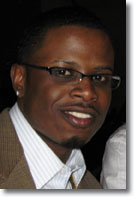 |
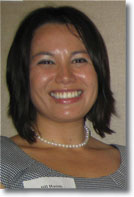 |
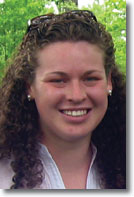 |
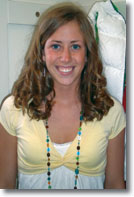 |
| Terrence Jordan | Jill Haom | Erin Morris | Sarah Hammon |
The Tucker Center attracts outstanding students from all across the country to come to the U of M and receive a first-rate educational and research experience. Our mission could not be better illustrated than by the four undergraduate interns who worked in the Tucker Center this summer. Two of the interns, Terrence Jordan and Jill Haom, were part of the U of M’s Ronald E. McNair Scholars cohort—a program designed to provide minority, disabled or low-income undergraduate students the research skills necessary to gain admission to and successfully complete their graduate study. Jordan, a Kinesiology major, worked with project mentors Heather Maxwell and Nicole LaVoi on a media project titled “Racial Representations of Women’s and Men’s Intercollegiate Basketball Coverage on ESPN.com.” This fall, Jordan began his Master’s program in Sport Psychology at Georgia Southern in Statesboro, GA.
Haom begins her senior year as a U of M Kinesiology major and works as a Program Assistant in the Department of Recreational Sports. Under the guidance of project mentors Chelsey Thul and LaVoi, Haom worked on the study “Unequal Opportunities, Unequal Outcomes: The Physical Activity of East African Girls,” which was funded by the Melpomene Institute for Women’s Health Research. Jordan and Haom finished their summer research assistantships by presenting their research at a University-wide McNair Scholars poster session last August. Haom was also one of five McNair Scholars selected to present their research at the 2008 National McNair Research Conference this October in Delavan, Wisconsin.
Our other two interns arrived at the Tucker Center from outside the U of M. Erin Morris is a senior majoring in Sociology with a Sport Studies minor at Whitman College in Walla Walla, Washington. Morris’ interest in Sport Sociology is fueled by her passion for playing and coaching hockey, as well as her experiences as a youth soccer referee. Sarah Hammon, a Psychology major with a minor in Sports Psychology, is in her last year of study at the University of Wisconsin, Eau Claire. After completing an internship at the St. Paul Children’s Hospital Exercise Medicine Clinic, Hammon’s interest in studying the impact of sport and exercise on children’s overall health and well-being led her to seek out the Tucker Center. Both Morris and Hammon worked with LaVoi on qualitative data analysis pertaining to the emotional (e.g., angry) responses of parents whose children are involved with youth sports.
The Tucker Center congratulates and applauds the work of these four young scholars who gained valuable experience and greatly contributed to our research endeavors this summer! For more information about internship opportunities, contact Dr. Nicole LaVoi, Associate Director of the Tucker Center, at nmlavoi@umn.edu or (612) 626-6055.
 I usually guard against chauvinism in the context of Olympic sports.
But I’ve lived in Minnesota long enough now that I couldn’t help but
feel a certain degree of Gopher Pride when athletes with connections to
our state and university had their moments on the global stage in
Beijing. The fact that so many of these athletes were women—Lindsey
Berg, Nicole Branagh, and Shani Marks among them—also got me thinking
about how gender plays into nationalism, human rights and globalization.
These are the issues I’ve been puzzling over since returning from the
second of my two recent trips to China.
I usually guard against chauvinism in the context of Olympic sports.
But I’ve lived in Minnesota long enough now that I couldn’t help but
feel a certain degree of Gopher Pride when athletes with connections to
our state and university had their moments on the global stage in
Beijing. The fact that so many of these athletes were women—Lindsey
Berg, Nicole Branagh, and Shani Marks among them—also got me thinking
about how gender plays into nationalism, human rights and globalization.
These are the issues I’ve been puzzling over since returning from the
second of my two recent trips to China.
Women (and gender) stood out at the Beijing Games in a variety of ways. For example, for the first time in Olympic history, American women won as many medals—53 according to the New York Times—as American men. (Four of the 110 U.S. medals were in mixed gender sports such as equestrian). Needless to say, these results underscore once again the success of Title IX and of the larger emphasis on girls and women in U.S. sport that has been championed so powerfully and consistently by folks in the Tucker Center over the past decade.
But before we pat ourselves on the back too much, it is worth noting that gender dynamics—and the consequences of international athletic competition—are quite different and even more striking in other parts of the world. In China, for instance, women accounted for 57 medals, some 15 more than Chinese men. This extends a pattern that has held since 1988. Indeed, when China first re-emerged on the international sports scene in the 1980s, it was their women’s volleyball team who led the way—defeating the Soviet Union, the United States, and, in the title match, Japan on their way to the 1981 World Cup championship and five consecutive world and Olympic titles.
There are many explanations for the success of Chinese women: A militarist-socialist system that treated them equally (if also harshly, by our standards); different conceptions of sex and gender; the existence of a cultural tradition, captured in the Disney movie Mulan, of women warriors who sacrifice themselves for the glory of the nation; and the fact that until recently, sport in China was a low-status activity that men didn’t feel compelled to dominate and control as they do in the West. But even today, as Susan Brownell pointed out in Beijing’s Games, many Chinese remember the 1981 women’s world volleyball championship as the turning point for national pride and patriotism not just in sport, but for the entire country, helping throw off the label of China as the “sick man” of East Asia.
The gender ironies here are delicious, and complicate our already complicated conceptions of China and its place in the new world order. But it is not just China we should be thinking about. Although we in the West often talk about nations and nationalism in abstract, gender-neutral terms, the distinctive roles of women and men in constituting nations and national identity are never far from the surface. What role do U.S. sportswomen play in the construction of our American national identity and pride? What role will women athletes around the world play as gender and national identities shift and change in an increasingly complex, global world? What role should they play? These are just a few of the ideas and questions we will be highlighting at the Tucker Center Distinguished Lecture on October 22. I hope you will join me and our three distinguished panelists that evening. We look forward to hearing your ideas and questions as well.
Doug Hartmann is an Associate Professor in the Department of Sociology and a Tucker Center Affiliated Scholar. His research examines race and ethnicity; sports; popular culture; and contemporary theory.
To highlight the contributions of female coaches and athletes at Beijing, a “by the numbers” analysis provides some interesting results. Data released by the USOC indicate that 26% (11 of 43) of all head coaches of women’s teams were female, while female athletes comprised 47% (276 of 585) of all athletes representing the United States. The U.S. team won 110 medals, including 36 gold medals. Overall, female athletes earned 48% (n=53) of all U.S. medals—15 gold, 23 silver and 15 bronze. This percentage includes gold medals for the beach volleyball, soccer, basketball and women’s eight rowing teams, and individual golds for gymnast Shawn Johnson, swimmer Natalie Coughlin and hurdler Dawn Harper.
Such accomplishments provide ample evidence that sportswomen compete—and succeed!—at the most elite levels of international competition. But they also indicate that more work needs to be done in terms of increasing the number of women head coaches at all levels of competition. For example, at the intercollegiate level nationwide, 42.8% of women’s teams are represented by female head coaches. For additional information pertaining to the employment trends of female coaches in intercollegiate sports, see Vivian Acosta and Linda Carpenter’s 2008 report.
Heather Maxwell and Jens Omli successfully defended their Ph.D. dissertations in May, and Chelsey Thul (née Rodd) completed her Masters degree in April.
Omli received a prestigious 2-year NIMH traineeship at the U of M’s Institute of Child Development to investigate the influence of angry parent behavior on psycho-physiological outcomes for youth sport participants. He will be mentored by internationally recognized scholars Dante Cicchetti and Nicki Crick.
Thul and Erin Becker each received a 2008-09 Eloise Jaeger Scholarship, an award which provides opportunities for students to meet their educational and career goals.
Diane Wiese-Bjornstal was elected to the President’s Council on Physical Fitness and Sports Science Advisory Board for 2009-12. The board’s activities include input on the President’s Challenge Program, as well as other initiatives related to physical activity and health across the lifespan.
Jo Ann Buysse received a U of M International Travel Grant to attend the Social Impact of Sport Governance and Management Conference in November at the Universita’ L. Bocconi, Milan, Italy.
Scholarly Activities
Nicole LaVoi, Maureen Weiss, and Wiese-Bjornstal delivered a panel presentation titled “Physical Activity as a Context for Youth Development” last May. The presentation was part of The Applied Research Collaborative on Youth Development’s Inquiry to Impact Series.
Mary Jo Kane presented results from the Women’s Sport Foundation Media Project, “The Portrayal of Female Athletes in the Media: Does Sex Really Sell?” to AP sports editors in Minneapolis at their annual convention in June.
Kane will also deliver a distinguished lecture, “Media, Gender and Sport in the 21st Century,” as part of the School of Arts & Sciences Diversity Initiative at Central Connecticut State University, New Britain, CT, in October.
Weiss will deliver an invited presentation, the Jo Safrit Lectureship, at the University of Wisconsin-Madison, in October.
Weiss, Jennifer Bhalla, Nicole Bolter, and Melissa Price presented two research papers at the annual conference of the North American Society for Psychology of Sport and Physical Activity (NASPSPA) in Niagara Falls last June. They presented data from their longitudinal study of positive youth development through participation in The First Tee program—“Life skills, youth development, and sport participation: Retention effects over a one-year period,” and “Lessons learned and core values adopted in a sports-based youth development program: A qualitative longitudinal analysis.” Price and Weiss also presented a paper at NASPSPA on their study of peer leadership among female adolescent athletes, “Peer leadership in sport: Characteristics, behaviors, and team outcomes.”
Buysse gave an invited presentation at the Minnesota Recreation & Park Association (MRPA) conference in Brainerd in September titled “Perceptions of Women as Leaders.”
For more information on what members of the Tucker Center are doing, visit our Tucker Center news blog ...
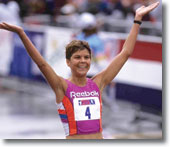 |
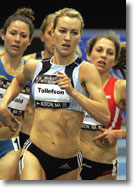 |
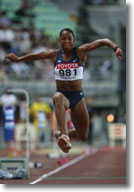 |
| Janis Klecker | Carrie Tollefson | Shani Marks |
The Tucker Center celebrates the participation and performance of female athletes at all levels—and this Fall we are honored to acknowledge a very elite group in our midst! The 2008 Distinguished Lecture will feature a trio of Minnesota’s finest female athletes—track & field Olympians Janis Klecker, Carrie Tollefson and Shani Marks.
Janis Klecker competed in the 1992 Olympic marathon in Barcelona, Spain—the same year she won the Olympic Trials. A native of Edina, and an alumnae of the U of M, Klecker is a five-time qualifier for the Olympic Trials, a Twin Cities Marathon champion and winner of countless other races. Such outstanding achievements have earned her a place in the U.S. Track & Field Minnesota Hall of Fame. Currently, Klecker holds the women’s world record for the 50K, a record she has held for over 25 years.
Carrie Tollefson began her career as a distance runner while growing up in Dawson, Minnesota. She was a 13-time Minnesota State High School Champion in both cross country and track & field. But her unprecedented achievements were just beginning. At Villanova, Tollefson continued her winning ways when she became a five-time NCAA Champion and 12-time All-American. During her post-collegiate career she has won a national championship in both cross county and indoor track. In the 2004 Olympics held in Athens, Greece, Tollefson competed in the 1500m race after winning the Olympic Trials.
Shani Marks, a native of Apple Valley, was a three-time All-American triple jumper and NCAA runner-up while competing for the U of M. Marks is also a two-time defending national champion in the indoor and outdoor triple jump, the current Olympic Trials champion, and just represented the United States in the triple jump at the Beijing Olympics. She is currently in her fourth season as a volunteer track & field coach for the U of M.
The performances of Olympic athletes inspire, captivate and pull at our heartstrings. But as we all know, the Olympics are not just about medals and wins and losses. They occur within a set of geopolitical issues related to gender, race, class, nationalism, capitalism and consumerism. To provide context for this complex set of issues—along with acknowledging the accomplishments of our amazing Minnesota athletes—University of Minnesota Professor of Sociology, Doug Hartmann, will provide a critique of the Olympics in general and the Beijing Olympics in particular. Last May, Hartmann co-taught “Beijing Olympics: Sports and Globalization,” a course for which his students travelled to Beijing to gain some first-hand knowledge of “history in the making.” Following his remarks, Hartmann will moderate a discussion with our featured Olympians where we will learn about their life histories, experiences and inspirations.
The Tucker Center is honored to host an evening that is sure to be stimulating, enlightening and inspirational. Please join us in celebrating the athletic achievements of some of Minnesota’s most accomplished female athletes.
To learn more about the event, go to our Distinguished Lecture site.

